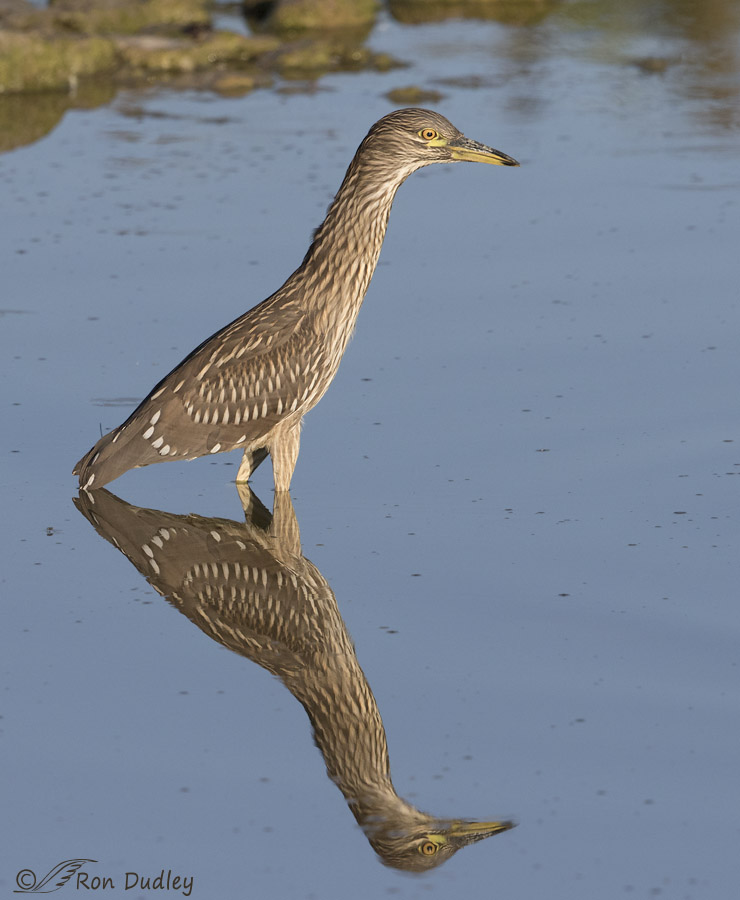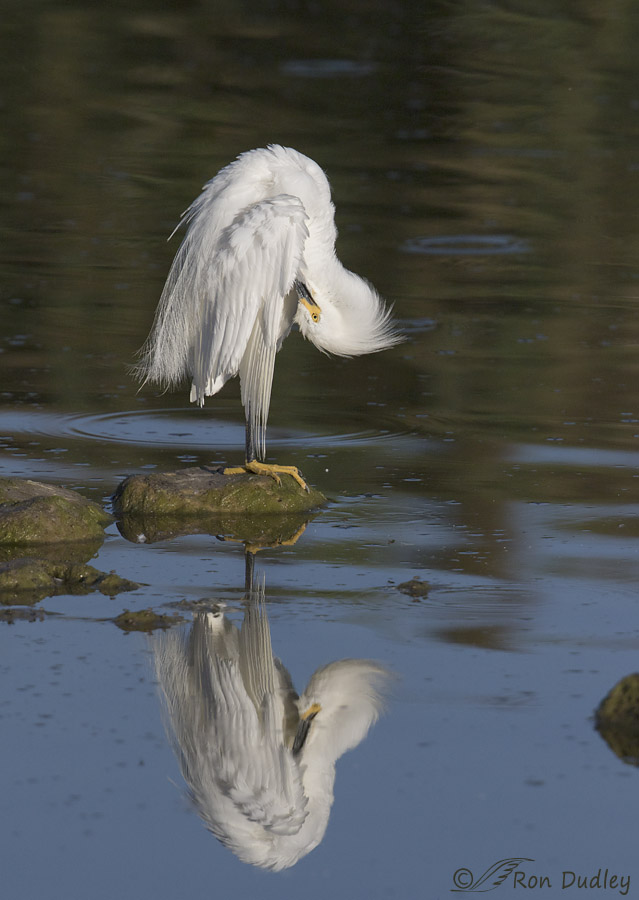I believe that many folks think that when there’s a reflection of a photo subject on the surface of water that reflection is an exact upside-down version of the way we see the subject itself (unless the reflection is disturbed by irregularities on the water surface). That’s really not the case.
A reflection occurs when light bounces off of an object (a bird for example), strikes the water surface and then travels to our eyes. What we see in the reflection is slightly different from what we see in the bird because the angle of light from the reflection to our eyes isn’t the same as it is from the bird itself. It’s difficult to explain without visual aids so I’ll use two images I took yesterday morning at Bear River MBR.

1/5000, f/6.3, ISO 800, Canon 7D Mark II, Canon EF500mm f/4L IS II USM, not baited, set up or called in
At first glance it may appear that the reflection from this juvenile Black-crowned Night Heron is an exact upside down version of the actual bird and its background but it isn’t. That fact is most easily seen here when we notice that there’s a small rock immediately above the head of the heron that is nowhere to be seen in the reflection. Think of it this way – what we’re actually seeing in the reflection is what we would see if our eyeballs were floating on the surface of the water where the reflection is. From that angle the rock would not be seen above the head of the bird.
Notice that we also see more of the underside plumage of the heron between the legs and tail in the reflection than we do in the bird itself. There are other more subtle differences too.
 1/3200, f/7.1, ISO 250, Canon 7D Mark II, Canon EF500mm f/4L IS II USM +1.4 tc, not baited, set up or called in
1/3200, f/7.1, ISO 250, Canon 7D Mark II, Canon EF500mm f/4L IS II USM +1.4 tc, not baited, set up or called in
Here’s another example that involves the bird more than the background. Notice that in the reflection we see about twice as much of the Snowy Egret’s beak than we do in the bird itself. That’s because the bird is reflected from below (where our imaginary eyeballs are) and at that angle we can see further up into the nooks and crannies of the plumage where the tip of the bill is.
Much ado about nothing perhaps but I believe the more we understand about our images the better. All this makes me think about artists who may paint or draw reflections and the things they must take into account if they want to make their work look realistic.
Ron


Very interesting lesson. Thank you. I never thought about it!
I wonder if this change in angle is something birder’s subconsciously process when they get “impressions” of light bellies, full breeding plumage, etc. in the field but can’t actually see the water’s eye angle. I will try to keep track of that when I’m looking at migrating waterfowl for the next few months. Thanks for an interesting lesson.
Interesting – I will never see a reflection the same way again. Thank you!
Great shots and very interesting commentary!
Charlotte
Can I add a plea that you don’t fix ALL of the Evil IPad’s wicked ways…
I enjoy them.
And my dyslexic fingers can create havoc without technology.
I always enjoy the additional features that a reflection gives. Some of the magic which otherwise escapes.
And I do love the heron in particular.
Thanks Ron.
Thanks, EC. Maybe I should email you a copy of Patty’s original unedited comment before I fix it…
I’m a beginner artist and find your observations quite useful as I try to develop my “visual brain” (as Liz Steel calls it). It’s easy to see what we THINK is there and overlook the real image.
Thanks, Linda – I’m delighted to know that you found this post useful.
Eveil iPad is at it again!!!…that was supposed to be darker, two, what …there are caps and punctuation where there isn’t supposed to be any…etc., etc., etc….I hate this thing!!!
I know you hate that damn thing, Patty, but I can’t help chuckling…
Anytime you (or anyone else) want’s me to edit and correct typos from this end just let me know and I will. I’m very reluctant to do it without being asked…
PLEASE DO!!! Thanks… My screen shows text so small I can barely read it and a lot slips by me even when I enlarge it…and enrage myself…
Patty, I actually work with iPads in my day job. I might have a tip or two to help you with the text. There is a setting that allows you to make the text larger overall. Feel free to drop me a line. I’d be happy to assist (no charge or anything…just helping a fellow FeatheredPhotography fan out!) readings AT tarotbyarwen DOT com.
Absolutely fascinating. I have never looked so closely at reflections before. It makes perfect sense that the reflection shows what faces the water rather than the side-on view that we have when looking at the birds. (Don’t know if that description makes sense.) I will be looking more closely at reflections from now on…
Makes perfect sense to me, Susan, but it is hard to explain, isn’t it?
An interesting reminder. A very fine artist and. Art instructor/art mentor once told me to remember that water is like a mirror and that an object’s reflection in the water is always going to be farker than the object itself. These ywo images are perfect examples. While we looknat the images straight on, the water/mirror reflects a different angle. Sometimes ehat youbsee and what you know are in conflict.
“Sometimes what you see and what you know are in conflict.”
In art and in photos as in life, huh, Patty?
Another reminder Is that the reflection is what the water/mirror “sees”, not what we see…..though similar in many respects, they aren’t necessarily the same….
Well said, Patty. And I fixed your typo
That’s what I was trying to say, Patty, but I think you said it much better. BTW, we just got an iPad and an iPhone a couple of weeks ago, and I totally understand the frustrations of trying to type on them…
Funny…I always think you and Susan “say it better”….good luck with your ownbevil iPad…you have my sympathy!!!
well, that is just amazing, things I never noticed before!
Good, I’m glad you found it interesting, Brenda. Thank you.